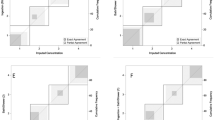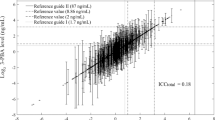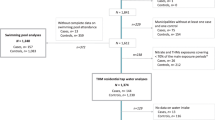Abstract
The Eastern Mediterranean and the Middle Eastern regions are both understudied in terms of possible environmental health risks for their populations. Water scarcity and desalination treatment provide the general population of countries from these regions (e.g., Kuwait and Cyprus) with unique tap water characteristics. This study investigated the association between external (tap water and 24 h personal air samples) and internal (urine) THM exposure metrics that reflected information about THM-related habits and activities collected using questionnaires and time activity diaries. The study population comprised of young females residing in either Kuwait (n=13) or Cyprus (n=22). First morning urine voids were collected on 2 consecutive days. Urinary creatinine-adjusted total THM (TTHM) levels were higher in Kuwait (median (interquartile range): 1044 (814, 1270) ng/g) than in Cyprus (691 (510, 919) ng/g, P<0.05). Median personal air TTHM levels in Kuwait (1.4 (0.7, 1.7) μg/m3) were higher than those in Cyprus (0.9 (0.5, 1.4) μg/m3), but did not reach statistical significance (P=0.17). Median tap water TTHM in Kuwait (6.7 (5.4, 11.6) μg/l) did not correlate with urinary or air THM and they were lower than those in Cyprus (29.5 (20.1, 48.0) μg/l; P<0.01). Despite that tap water did not contain chloroform (TCM), TCM was detected in both air and urine samples in Kuwait, suggesting other TCM exposure sources, such as household cleaning activities. Total duration of activities and mopping were significantly correlated with air and urine THM in Kuwait, as reported in the time activity diary. Personal air and urine exposure metrics were correlated in Kuwait (TTHM ρ=0.62, P<0.05), but not in Cyprus (TTHM ρ=−0.32, P>0.05). Time-activity diaries and urinary THM seemed to be useful measures of THM exposures in Kuwait. Coupling both external with internal exposure metrics could find use in population health studies towards further refining the association between environmental exposures and health outcomes.
This is a preview of subscription content, access via your institution
Access options
Subscribe to this journal
Receive 6 print issues and online access
$259.00 per year
only $43.17 per issue
Buy this article
- Purchase on Springer Link
- Instant access to full article PDF
Prices may be subject to local taxes which are calculated during checkout
Similar content being viewed by others
References
Agus E, Voutchkov N, Sedlak DL . Disinfection by-products and their potential impact on the quality of water produced by desalination systems: a literature review. Desalination 2009; 237: 214–237.
Al-Mudhaf H, Astel AMA l. M, Selim MIMI, Abu-Shady A-SI . Self-organizing map approach in assessment spatiotemporal variations of trihalomethanes in desalinated drinking water in Kuwait. Desalination 2010; 252: 97–105.
Charisiadis P, Andra SS, Makris KC, Christodoulou M, Christophi CA, Kargaki S et al. Household cleaning activities as non-ingestion exposure determinants of urinary trihalomethanes. Environ Sci Technol 2014; 48: 770–780.
Stayner LT, Pedersen M, Patelarou E, Decordier I, Vande Loock K, Chatzi L et al. Exposure to brominated trihalomethanes in water during pregnancy and micronuclei frequency in maternal and cord blood lymphocytes. Environ Health Perspect 2014; 122: 100–106.
Font-Ribera L, Kogevinas M, Nieuwenhuijsen MJ, Grimalt JO, Villanueva CM . Patterns of water use and exposure to trihalomethanes among children in Spain. Environ Res 2010; 110: 571–579.
Savitz DA, Singer PC, Herring AH, Hartmann KE, Weinberg HS, Makarushka C . Exposure to drinking water disinfection by-products and pregnancy loss. Am J Epidemiol 2006; 164: 1043–1051.
Rivera-Núñez Z, Wright JM . Association of brominated trihalomethane and haloacetic acid exposure with fetal growth and preterm delivery in Massachusetts. J Occup Environ Med 2013; 55: 1125–1134.
Cao W-C, Zeng Q, Luo Y, Chen H-X, Miao D-Y, Li L et al. Blood biomarkers of late pregnancy exposure to trihalomethanes in drinking water and fetal growth measures and gestational age in a Chinese cohort. Environ Health Perspect 2015; 124: 536–541.
Grazuleviciene R, Nieuwenhuijsen MJ, Vencloviene J, Kostopoulou-Karadanelli M, Krasner SW, Danileviciute A et al. Individual exposures to drinking water trihalomethanes, low birth weight and small for gestational age risk: a prospective Kaunas cohort study. Environ Health 2011; 10: 32.
Infante-Rivard C . Drinking water contaminants, gene polymorphisms, and fetal growth. Environ Health Perspect 2004; 112: 1213–1216.
Haddad S, Tardif G-C, Tardif R . Development of physiologically based toxicokinetic models for improving the human indoor exposure assessment to water contaminants: trichloroethylene and trihalomethanes. J Toxicol Environ Health A 2006; 69: 2095–2136.
Cammann K, Hübner K . Trihalomethane concentrations in swimmers’ and bath attendants’ blood and urine after swimming or working in indoor swimming pools. Arch Environ Health 1995; 50: 61–65.
Caro J, Gallego M. Assessment of exposure of workers and swimmers to trihalomethanes in an indoor swimming pool. Environ Sci Technol 2007; 41: 4793–4798..
Gemma S, Vittozzi L, Testai E. Metabolism of chloroform in the human liver and identification of the competent P450s. Drug Metab Dispos 2003; 31: 266–274.
Polkowska Ż, Kozłowska K, Mazerska Z, Górecki T, Namieśnik J . Relationship between volatile organohalogen compounds in drinking water and human urine in Poland. Chemosphere 2003; 53: 899–909.
Miles AM, Singer PC, Ashley DL, Lynberg MC, Mendola P, Langlois PH et al. Comparison of trihalomethanes in tap water and blood. Environ Sci Technol 2002; 36: 1692–1698.
Rivera-Núñez Z, Wright JM, Blount BC, Silva LK, Jones E, Chan RL et al. Comparison of trihalomethanes in tap water and blood: a case study in the United States. Environ Health Perspect 2012; 120: 661–667.
AlSeaidan M, Al Wotayan R, Christophi CA, Al-Makhseed M, Abu Awad Y, Nassan F et al. Birth outcomes in a prospective pregnancy-birth cohort study of environmental risk factors in Kuwait: the TRACER Study. Paediatr Perinat Epidemiol 2016; 30: 408–417.
Lauritsen J . EpiData Data Entry, Data Management and Basic Statistical Analysis System. EpiData Association: Odense, Denmark. 2000.
Charisiadis P, Makris KC . A sensitive and fast method for trihalomethanes in urine using gas chromatography - triple quadrupole mass spectrometry. J Chromatogr B 2013; 947–948: 17–22.
MAKPart IV: biomonitoring methods In Angerer J, Hartwig A eds The MAK-Collection for Occupational Health and Safety. Wiley-VCH Verlag GmbH: Weinheim. 2010 p 169–184.
Chung C-W, Morandi MT, Stock TH, Afshar M . Evaluation of a passive sampler for volatile organic compounds at ppb concentrations, varying temperatures, and humidities with 24- h exposures. 2. Sampler performance. Environ Sci Technol 1999; 33: 3666–3671.
R Core Team. R: A language and environment for statistical computing 2015. https://www.r-project.org/.
Riederer AM, Bartell SM, Ryan PB . Predictors of personal air concentrations of chloroform among US adults in NHANES 1999-2000. J Expo Sci Environ Epidemiol 2009; 19: 248–259.
Dallongeville A, Costet N, Zmirou-Navier D, Le Bot B, Chevrier C, Deguen S et al. Volatile and semi-volatile organic compounds of respiratory health relevance in French dwellings. Indoor Air 2016; 26: 426–438.
Lourencetti C, Grimalt JO, Marco E, Fernandez P, Font-Ribera L, Villanueva CM et al. Trihalomethanes in chlorine and bromine disinfected swimming pools: air-water distributions and human exposure. Environ Int 2012; 45: 59–67.
Riederer AM, Dhingra R, Blount BC, Steenland K . Predictors of blood trihalomethane concentrations in NHANES 1999-2006. Environ Heal Perspecitves 2014; 122: 695–702.
Weisel CP, Zhang JJ, Turpin BJ, Morandi MT, Colome S, Stock TH et al Relationships of indoor, outdoor, and personal air (RIOPA): Part I. Collection methods and descriptive analyses. Health Effects Institute: Boston, MA; Mickey Leland National Urban Toxics Research Cernter: Houston, TX, 2005. HEI Research Report 130; NUATRC Research Report 7, 93–95.
Wallace La, Pellizzari ED, Hartwell TD, Whitmore R, Zelon H, Perritt R et al. The California TEAM study: breath concentrations and personal exposures to 26 volatile compounds in air and drinking water of 188 residents of Los Angeles, Antioch, and Pittsburg, CA. Atmos Environ 1988; 22: 2141–2163.
Acknowledgements
We thank the Kuwait Foundation for the Advancement of Science and Dasman Diabetes Institute for providing support for this study and the Cyprus Research Promotion Foundation for partially funding this study with Structural Funds of the European Commission through the Cypriot Operational Programme “Sustainable Development and Competitiveness” (Project Protocol Number: AEIFORIA/ASTI/0311(BIE)/20). We thank the participants and the whole TRACER team for their efforts in organizing the personal sampling and collecting the samples, especially Smitha Abraham, Lama El-Helou Makka Osman.
Author information
Authors and Affiliations
Corresponding author
Ethics declarations
Competing interests
The authors declare no conflict of interest.
Additional information
DISCLAIMER
The observations and speculations in this article represent those of the authors and do not necessarily reflect the views of the participating organizations, viz., Cyprus University of Technology, Limassol, Cyprus, Kuwait University and Harvard University.
Supplementary Information accompanies the paper on the Journal of Exposure Science and Environmental Epidemiology website
Supplementary information
Rights and permissions
About this article
Cite this article
Gängler, S., Makris, K., Bouhamra, W. et al. Coupling external with internal exposure metrics of trihalomethanes in young females from Kuwait and Cyprus. J Expo Sci Environ Epidemiol 28, 140–146 (2018). https://doi.org/10.1038/jes.2017.27
Received:
Accepted:
Published:
Issue Date:
DOI: https://doi.org/10.1038/jes.2017.27
Keywords
This article is cited by
-
Urinary trihalomethane concentrations and liver function indicators: a cross-sectional study in China
Environmental Science and Pollution Research (2023)
-
Exposure to disinfection byproducts and risk of type 2 diabetes: a nested case–control study in the HUNT and Lifelines cohorts
Metabolomics (2019)



